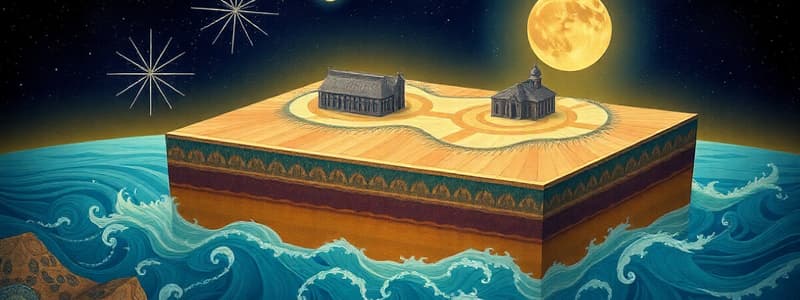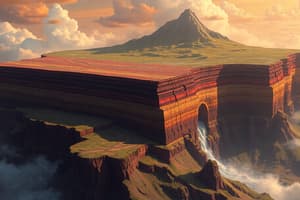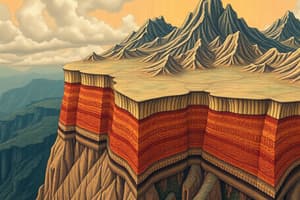Podcast
Questions and Answers
Which layer of the Earth is the outermost?
Which layer of the Earth is the outermost?
- Crust (correct)
- Mantle
- Outer Core
- Core
What is the approximate average thickness of continental crust?
What is the approximate average thickness of continental crust?
- 7 kilometers
- 70 kilometers
- 35 kilometers (correct)
- 2900 kilometers
Which part of the mantle allows movement of tectonic plates?
Which part of the mantle allows movement of tectonic plates?
- Asthenosphere (correct)
- Lower Mantle
- Inner Core
- Outer Core
Which of the following best describes the outer core?
Which of the following best describes the outer core?
Which layer is the thickest?
Which layer is the thickest?
What is the average thickness of oceanic crust?
What is the average thickness of oceanic crust?
Which layer is the innermost layer of the Earth?
Which layer is the innermost layer of the Earth?
What is the inner core made of?
What is the inner core made of?
What is the approximate thickness of the Earth's inner core?
What is the approximate thickness of the Earth's inner core?
Which layer of the Earth is the thickest?
Which layer of the Earth is the thickest?
What geological feature is created at divergent plate boundaries on land?
What geological feature is created at divergent plate boundaries on land?
What process occurs at divergent plate boundaries?
What process occurs at divergent plate boundaries?
What geological event is common at transform boundaries?
What geological event is common at transform boundaries?
Which of the following is formed by the collision of the Indian and Eurasian plates?
Which of the following is formed by the collision of the Indian and Eurasian plates?
What primarily happens when two continental plates collide at a convergent boundary?
What primarily happens when two continental plates collide at a convergent boundary?
Approximately what percentage of Earth's water is found in oceans?
Approximately what percentage of Earth's water is found in oceans?
Which ocean is the largest and deepest on Earth?
Which ocean is the largest and deepest on Earth?
The Mid-Atlantic Ridge is a prominent feature of which ocean?
The Mid-Atlantic Ridge is a prominent feature of which ocean?
Which ocean is known as the warmest ocean in the world?
Which ocean is known as the warmest ocean in the world?
The smallest and coldest of the five oceans is the:
The smallest and coldest of the five oceans is the:
What geological event is commonly associated with transform boundaries?
What geological event is commonly associated with transform boundaries?
Which ocean encircles Antarctica?
Which ocean encircles Antarctica?
What is the name of the supercontinent that existed approximately 300 million years ago?
What is the name of the supercontinent that existed approximately 300 million years ago?
Which sea is bordered by Europe, Africa, and Asia?
Which sea is bordered by Europe, Africa, and Asia?
Which sea is located between Alaska and Russia?
Which sea is located between Alaska and Russia?
Which scientist proposed the theory of continental drift?
Which scientist proposed the theory of continental drift?
What type of plate boundary is associated with the creation of new crust?
What type of plate boundary is associated with the creation of new crust?
Which of the following was NOT a major landmass formed after Pangaea broke apart?
Which of the following was NOT a major landmass formed after Pangaea broke apart?
Fossils of which plant have been found in Antarctica, suggesting it was once in a warmer region?
Fossils of which plant have been found in Antarctica, suggesting it was once in a warmer region?
What percentage of Earth's surface is covered by land?
What percentage of Earth's surface is covered by land?
The San Andreas Fault in California is an example of which type of plate boundary?
The San Andreas Fault in California is an example of which type of plate boundary?
Flashcards
Crust
Crust
The outermost and thinnest layer of Earth, ranging from 5 to 70 km thick.
Continental Crust
Continental Crust
The thicker part of the Earth's crust found under continents, averaging 35 km thick
Oceanic Crust
Oceanic Crust
The thinner part of the Earth's crust found under ocean basins, averaging 7 km thick.
Mantle
Mantle
Signup and view all the flashcards
Upper Mantle
Upper Mantle
Signup and view all the flashcards
Lower Mantle
Lower Mantle
Signup and view all the flashcards
Core
Core
Signup and view all the flashcards
Outer Core
Outer Core
Signup and view all the flashcards
Tectonic Plates
Tectonic Plates
Signup and view all the flashcards
Divergent Plate Boundaries
Divergent Plate Boundaries
Signup and view all the flashcards
Convergent Plate Boundaries
Convergent Plate Boundaries
Signup and view all the flashcards
Transform Plate Boundaries
Transform Plate Boundaries
Signup and view all the flashcards
Himalayas Formation
Himalayas Formation
Signup and view all the flashcards
Transform Boundaries
Transform Boundaries
Signup and view all the flashcards
Divergent Boundaries
Divergent Boundaries
Signup and view all the flashcards
Convergent Boundaries
Convergent Boundaries
Signup and view all the flashcards
Pangaea Theory
Pangaea Theory
Signup and view all the flashcards
Continental Fit
Continental Fit
Signup and view all the flashcards
Fossil Evidence
Fossil Evidence
Signup and view all the flashcards
Geological Similarities
Geological Similarities
Signup and view all the flashcards
Laurasia
Laurasia
Signup and view all the flashcards
Pacific Ocean
Pacific Ocean
Signup and view all the flashcards
Atlantic Ocean
Atlantic Ocean
Signup and view all the flashcards
Indian Ocean
Indian Ocean
Signup and view all the flashcards
Arctic Ocean
Arctic Ocean
Signup and view all the flashcards
Southern Ocean
Southern Ocean
Signup and view all the flashcards
Mediterranean Sea
Mediterranean Sea
Signup and view all the flashcards
Caribbean Sea
Caribbean Sea
Signup and view all the flashcards
Bering Sea
Bering Sea
Signup and view all the flashcards
Study Notes
- Distribution of the continents and crustal features involve continental drift and plate tectonics, influencing current continental and crustal distributions
- Studying Earth's dynamic nature includes an appreciation for the importance of geological changes and how they impact human life, ecosystems, and natural disasters.
Layers of the Earth
- The Earth features multiple layers: crust, mantle, and core.
- The Earth's crust is outermost layer and it is also the thinnest, ranging from 5-70 km in thickness
- Continental and oceanic crust are two types of crust.
- The continental crust lies underneath continents with an average thickness 35 km.
- The oceanic crust resides under ocean basins and as an average thickness of about 7 km
Earth's Mantle
- The thickest layer, the mantle, extends approximately 2,900 km from the crust's base.
- The mantle has has two layers: the upper & lower mantle
- The rigid upper mantle contains the asthenosphere which allows for tectonic plate movment
- The solid lower mantle contributes to convention & heat transfer within the earth's interior.
Earth's Core
- The innermost layer of Earth is the core, which lies beneath the mantle and is divided into 2: outer and inner core
- The liquid outer core is mainly composed of molten iron and nickel that measures about 2,300 km thick
- The inner core is the solid, central part of the earth.
- The inner core has a 1,220 km radius and consists of solid iron and nickel.
Plate Tectonic Theory
- The Earth is composed of a rigid outer layer, known as lithosphere.
- Lithosphere is broken into large, rigid pieces called tectonic plates.
- These plates float and move on a semi-fluid asthenosphere which is a hot, slowly-flowing part of the mantle.
Types of Plate Boundaries
-
Divergent Boundaries (Sliding Plates): Plates move away from each other.
-
This movement leads to formation of new crust when magma rises from the mantle, solidifies, and forms new oceanic crust.
-
Convergent Boundaries: These areas are where tectonic plates come together, resulting in different geological events.
-
Convergent boundaries encourage the formation of mountains, volcanic activity, and earthquakes.
-
Transform Boundaries: where two plates slide past each other horizontally.
-
Transform boundaries redistribute stress and adjust movement between neighboring plates.
-
Transform boundaries do not create or destory crusts because the plates simply grind against each other horizontally.
Divergent Boudaries
- On land, divergent plate boundaries create mid-ocean ridges and rift valleys.
- Divergent plate boundaries can stretch and thin the crust, cause the land to sink leading to volcanic activity since magma from the mantle rises.
- The Mid-Atlantic Ridge exemplifies a divergent boundary.
Convergent Boundaries
- When 2 continental plates collide due to low desnity neither plate is subducted
- The two plates compress and buckle, leading to uplifted mountian ranges.
- The Himalayas formed through the collision of the Indian and Eurasian plates.
Transform Boundaries
- Earthquakes are caused by the build-up and sudden release of stress from plates grinding against each other.
- The San Adreas fault is an example of this phenomenon.
Pangaea Theory
- Alfred Wegener proposed the Pangaea Theory which is also known as the Continental Drift Theory in 1912.
- 300 million years ago, continents came together forming a massive landmass called Pangaea which is Greek for "all Earth"
- Over time, Pangaea gradually broke apart allowing continents to to drift to their current positions.
Evidence Supporting the Pangaea Theory
- Continental Fit: The coastlines of continents fit together like puzzle pieces.
- Fossil Evidence: Fossils of ancient plants and animals were found on continents separated by vast oceans.
- Rock and Mountain Similarities: Similar rock formations and mountain ranges appear in faraway continents.
- Climate Evidence: Fossilized remains of tropical plants are found in Antarctica, suggesting it was in a warmer climate.
Breakup of Pangaea
- 200 years ago Pangaea began to break apart because of tectonic plate movement. creating Laurasia & Gondwana
- Laurasia contains North America, Europe & Asia
- Gondwana contains South America, Africa, Antartica, Australia, & India
Distribution of Land and Water
- Continents, oceans/seas, and major landforms
The Seven Continents
- 29% of Earth consists of land mass
- 71% of Earth consists of water
- The vast majority of Earth's water, approximately 97%, is in oceans while around 3% of it is freshwater
Asia
- Asia is the largest continent by area that covers about 44.58 million square kilometers
- Asia is highly linguistically diverse with thousands of languages are spoken
- Asia has a rich culture marked by history, art, philosophy, and arcitecture
- Asia's population is over 4.7 billion, making it the most populous continent.
Africa
- Africa's population is over 1.3 billion
- Africa's cultural history is rich with art, music dance, and oral traditions
- Africa is highly linguistically diverse with over 2,000 different languages are spoken
- Africa is the world's 2nd largest continent, covering about 30.37 million square kilometers
North America
- North America's population has about 579 million people
- Enlgish, Spanish, & French are commonly spoken there
- Is the 3rd-largest continent, covering about 24.71 million square kilometers North America is home to various ethnic groups, making it a multicultural region.
South America
- South America's population has about 430 million people
- Spans about 17.84 million square kilometers, making it the 4th-largest continent
- Rich in heritage influenced by Indigenous, and a blend of European and African cultures
- Spanish, Portuguese, and other Indigenous languagues are widely spoken
Antarctica
- Antarctica is the coldest, driest, and windiest continent
- Antarctica is the fifth-largest continent that covers about 14 million square kilometers
- Antarctica is not inhabited permanently by humans, but some reseach stations have fluctuating people
- Antarctica is home to penguins, seals, and seabirds
Europe
- Europe is known as the cradle of Western civilization.
- Europe is the third most populous continental in the world
- Europe covers about 10.18 million square kilometers, making it the second smallest contenent.
- Europe's linguistic makeup has over 200 different languages
Austrailia
- Australia has approximately over 25 million people.
- Australia's area is the smallest of the continents covering about 7.7 million square kilometers
- Australia is home to many diverse communities.
- Austrailia's widely spoken language is Austrailian English, which also serves as the official language.
The Five Major Oceans
- The majority of Earth's surface is dominated by water
Pacific Ocean
- Extends from artic to Sourthern ocean. covering 30% of plantet
- It is the largest and deepest ocean on Earth, covering more than 30% of the planet's surface
Atlantic Ocean
- Separates the continents of North and South America from Europe and Africa.
- Is well-known for the Mid-Atlantic Ridge, where there resides a massive underwater mountain range to runs along the centers
Indian Ocean
- The third-largest ocean, it's primarily located in the Southern Hemisphere.
- The Ocean in the North, Africa to the West, and Australia to the East boarder Asia
- This ocean is vital to regions for monsoon weather patterns.
Arctic Ocean
- This smallest of the five oceans is in the North Pole
- It is often the year covered in ice, but climate change is making it shrink
Southern Ocean
- Plays a major role in climate, influencing currents & acting as carbon sink.
- It's home to some of the world's extreme climate with strong winds and icy waters
- The Sourthern Ocean encircles Antarctica.
Famous Seas
- Seas are salty bodies of water that home many different organisms.
- As opposed to oceans, seas are far smaller and enclosed by Land
Mediterranean Sea
- Hub for trade, cultural exchange, militaristic conflict.
- It served as the epicenter of acient civilizations like Eqyptians, Greeks, Romans, Phoenicians
- Important sea that is located between Africa, Asia, Euproe, and has played a pivotal role in human history
Caribbean Sea
- Home to the Bahamas, Cuba, Jamaica, etc.
- Tropical sea famous for color and clear water
- In West Hem bordered by S/Central America
- Influenced by indigenous people, European colonization etc/
Bering Sea
- Supplies seafood like pollock and crab.
- Connects Asia and North America.
- Significant for animals like whales, seals, fish.
- A Cold northern sea located between Russia and AlaskaUSA and makes a part of pasific ocean
Red Sea
- The rich marine life makes it the main destination for marine divers and marine biologists.
- One of saltines due to low rainfall and high evaporation
- Runs between north eastern Africa and the Arabin Penninsula.
Baltic Sea
- Unique ecosystem due to low salinity in season ice
- Mixture of freshwater and saltwater located between Northern Europe and Russia.
- Touches Germany, Sweden FIN and Esto etc.
Major Landforms
- Mountains, Plains, and Plateaus
Mountains
- Mountains generally formed volcanic activity, erosin, or plateonic movement
- Large natural landforms with high rising levels on earth
Plateaus
- Flat tops called tableland
- A plateau is a flat, elevated landform that rises sharply above the surrounding area
Studying That Suits You
Use AI to generate personalized quizzes and flashcards to suit your learning preferences.
Description
Test your understanding of Earth's structure, including the crust, mantle, and core. Learn about plate tectonics, the different types of plate boundaries, and their associated geological features. Explore ocean basics, including size and features.




